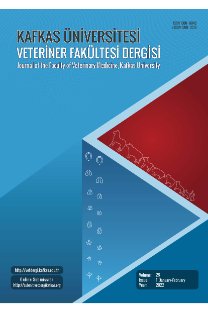Hematologic and Biochemical Reference Intervals for Captive Asian Elephants (Elephas maximus) in Thailand
Tayland’da Evcil Asya Filinin (Elephas maximus) Kan ve Biyokimyasal Referans Aralıkları
___
- 1. White PT, Brown IR: Elephant blood haematology and chemistry. Comp Biochem Phys B, 65, 1-12, 1980. DOI: 10.1016/0305-0491(80)90107-8
- 2. Gromadzka-Ostrowska J, Jakubów K, Zalewska B, Krzywicki Z: Haematological and blood biochemical studies in female domesticated Indian elephants (Elephas maximus L.). Comp Biochem Phys A, 89, 313-315, 1988. DOI: 10.1016/0300-9629(88)91031-6
- 3. Salakij J, Salakij C, Narkkong NA, Apibal S, Suthunmapinuntra P, Rattanakukuprakarn J, Nunklang G, Yindee M: Hematology, cytochemistry and ultrastructure of blood cells from Asian elephant (Elephas maximus). Kasetsart J (Nat Sci), 39, 482-493, 2005.
- 4. Pintavongs W, Chueplaivej P, Boonyasart B, Kidyhoo S, Pravai W, Rattanakunuprakarn J, Ounsiri S, Lorsanyaluck B, Sunyathitiseree P, Jittapalapong S, Wajjwalku W, Thongtip N: Domestic elephant population structure and health status in Thailand. J Kasetsart Vet, 24 (1): 16-24, 2014.
- 5. Padalino B, Rubino G, Lacinio R, and Petazzi F: Observations on the hematology of standardbred horses in training and racing in southern Italy. J Equine Vet Sci, 34, 398-402, 2014. DOI: 10.1016/j.jevs.2013.07.018
- 6. Calkosinski I, Gamian A, Kobierska-Brzoza J, Fita K, CzajczynskaWaszkiewicz A, Majda J, Calkosinska M, Parulska O, Dobrzynski M: The influence of variable environmental factors on human’s organism adaptive ability. Adv Clin Exp Med, 5, 519-527, 2009.
- 7. Yaqub Y: Influence of reproductive cycle, sex, age and season on haematologic parameters in domestic animals: a review. J Cell Anim Biol, 7, 37-43, 2013. DOI: 10.5897/JCAB12.063
- 8. International Species Information System: Physiological reference values for elephant. http://www.elephantcare.org/isismain.htm, Accessed: 25.02.2016 . 9. De Mel RK, Weerakoon DK, Ratnasooriya WD, and Dangolla A: A comparative haematological analysis of Asian elephants (Elephas maximus Linnaeus, 1758 [Mammalia: Proboscidea: Elephantidae]) managed under different captive conditions in Sri Lanka. J Threat Taxa, 6, 6148- 6150, 2014. DOI: 10.11609/JoTT.o3761.6148-50
- 10. De Alwis GKH, Wijesekera RD, Vithana D, Neththasinghe N, and Ratnasooriya WD: Serum levels of some biochemical constituents of captive Sri Lankan elephants (Elephas maximus maximus). J Sci Univ Kelaniya, 2, 105-114, 2005. DOI: 10.4038/josuk.v2i0.2749
- 11. Marchal J, Dorieux O, Haro L, Aujard F, and Perret M: Characterization of blood biochemical markers during aging in the Grey Mouse Lemur (Microcebus murinus): Impact of gender and season. BMC Vet Res, 8, 211, 2012. DOI: 10.1186/1746-6148-8-211
- 12. Sutherland MA, Niekamp SR, Rodriguez-Zas SL, Salak-Johnson JL: Impacts of chronic stress and social status on various physiological and performance measures in pigs of different breeds. J Anim Sci, 84, 588-596, 2006. DOI: 10.2527/2006.843588x
- 13. R Core Team: R: A Language and Environment for Statistical Computing. Vienna, Austria: R Foundation for Statistical Computing. http://www.R-project.org, Accessed: 12.06. 2016.
- 14. Finnegan D: Package reference Intervals. http://cran.rproject.org/ web/packages/referenceIntervals/index.html, Accessed: 12.06. 2016.
- 15. Dastjerdi A, Seilern-Moy A, Darpel K, Steinbach F, and Molenaar F: Surviving and fatal Elephant Endotheliotropic Herpesvirus-1A infections in juvenile Asian elephants - Lessons learned and recommendations on anti-herpesviral therapy. BMC Vet Res, 12, 178, 2016. DOI: 10.1186/s12917- 016-0806-5
- 16. Salakij C: Veterinary Hematology. Department of Pathology, Faculty of Veterinary Medicine Kasetsart University, Bangkok, 2005. ISBN: 9745377406
- 17. Fowler ME, Mikota SK: Biology, Medicine, and Surgery of Elephants. Blackwell, United Kingdom, 2006. ISBN-13: 978-0-8138-0676-1; ISBN-10: 0-8138-0676- 3
- 18. Etim NN, Williams ME, Uduak A, Offiong EEA: Haematological parameters and factors affecting their values. Agr Sci, 2, 37-47, 2014. DOI: 10.12735/as.v2i1p37
- 19. Silva ID, Kurawita VY: Hematology, plasma, and serum biochemistry vales in domesticated elephants (Elephas maximus ceylonicus) in Sri Lanka. J Zoo Wildlife Med, 24, 434-439, 1993.
- 20. Niemuller C, Gentry PA, and Liptrap RM: Longitudinal study of haematological and biochemical constituents in blood of the Asian elephant (Elephas maximus). Comp Biochem Physiol A, 96, 131-134, 1990. DOI: 10.1016/0300-9629(90)90053-U
- ISSN: 1300-6045
- Yayın Aralığı: 6
- Başlangıç: 1995
- Yayıncı: Kafkas Üniv. Veteriner Fak.
Jun ZHAO, Xing-xu YI, Hai-yang YU, Ming-li WANG, Peng-fei LA, Lin GAN, Yu ZHAO, Xiu-le FU, Jason CHEN
Investigation on Diagnosis and Metabolic Profile of Ovarian Cysts in Dairy Cows
Nora MIMOUNE, Rachid KAIDI, Mohamed Yassine AZZOUZ, Safia ZENIA, Mohamed Hocine BENAISSA, Gary ENGLAND
Bir Kedide Nasofarengeal Polip Traksiyon-Avulziyonu Sonucu Gelişen Geçici Horner Sendromu
F. Eser ÖZGENCİL, Çağrı GÜLTEKİN, Gökhan ULUKAN
ARTUN YIBAR, FİGEN ÇETİNKAYA, GÜL ECE SOYUTEMİZ, Görkem YAMAN
Thittaya JANYAMETHAKUL, Supaphen SRIPIBOON, Chalermchat SOMGIRD, Pornsawan PONGSOPAWIJIT, Veerasak PANYAPORNWITHAYA, Sarisa KLINHOM, Jarunee LOYTHONG, Chatchote THITARAM
Abdul MALIK, Muhammad SYARIFDJAYA, Aam GUNAWAN, Siti ERLINA, Achmad JAELANI, Dadang Budi WIBOWO
Antimicrobial Resistance and Virulence Characteristics in Enterococcus Isolates from Dogs
Yılmaz BOYAR, Özkan ASLANTAŞ, SÜHEYLA TÜRKYILMAZ
Risperidone as a Promising Treatment of Choice in Dog Owner Directed Aggression
DUYGU DALĞIN, YÜCEL MERAL, METİN ÇENESİZ
Nana HU, Qiang FU, Shengwei HU, Mengting SHI, Huijun SHI, Wei NI, Jinliang SHENG, Chuangfu CHEN
Monitoring of Nosema Infections Levels During Hygienic Honey Bee Breeding Programs in Turkey
